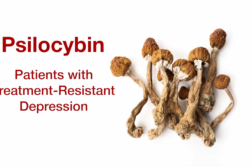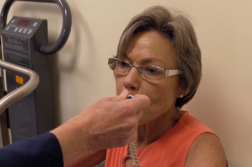ORLANDO, Fla. (Ivanhoe Newswire) — In 2016, more than 350 thousand people suffered an out-of-hospital cardiac arrest. Most of them died. Fear of performing CPR incorrectly may ward off those who could potentially help. Now, an innovative solution is giving people the confidence and skills they need to save lives.
Less than eight percent of people who suffer cardiac arrest outside of the hospital survive. Marivaldo Soares beat those chilling odds.
“The last words I said, was “wow” and then I immediately fell on the table,” Soares said.
Soares is lucky to be alive. Three of his colleagues knew how to perform CPR until the paramedics arrived and took over.
“CPR really saved my life. It’s amazing,” continued Soares.
CPR can double or even triple a victims chance of survival. Yet less than 32 percent of victims receive CPR from a bystander. Breathing into a stranger’s mouth may be the problem. Now, the American Heart Association supports simple, hands only, CPR.
Lasonia Landry, Executive Director, American Heart Association for Greater Orlando said, “Hands only CPR is just as effective as traditional CPR and it’s a little bit faster to learn and it’s easier to retain.”
Training kiosks are being placed in crowd-heavy areas like convention centers and airports.
Landry continued, “It takes about five minutes from watching the video, practicing the compressions, and taking the test.”
That’s faster than waiting for an ambulance in an emergency. The average wait time for EMS can be eight to fourteen minutes. CPR in that time is the difference in life and death for thousands.
The kiosk breaks it down into three components; instruction, practice, and the final testing phase.
“If we can show and we can teach more people hands on CPR, then we are creating a whole new generation of life savers,” Landry stated.
And, saving the lives of our loved ones, as four out of five cardiac arrests happen at home.
A new survey from the Cleveland Clinic found slightly half of Americans say they know CPR, but only one in six know the recommended technique consists of just chest compressions. Almost every state has “Good Samaritan” laws that protect a bystander who tries to help. Currently, these training kiosks can be found at several locations, including international airports in Dallas, Harrisburg, Chicago O’Hare, Indianapolis, Dayton, and Orlando.
Contributors to this news report include: Cyndy McGrath/Gabriella Battistiol, Producer; Bob Walko, Editor and Jesse Draus, Videographer.
Free weekly e-mail on Medical Breakthroughs from Ivanhoe. To sign up: http://www.ivanhoe.com/ftk
LEARN TO SAVE A LIFE IN FIVE MINUTES!
REPORT #2499
BACKGROUND: Every 40 seconds, someone in the United States has a heart attack. A heart attack, also called a myocardial infarction, occurs when a part of the heart muscle doesn’t receive enough blood flow. The more time that passes without treatment to restore blood flow, the greater the damage to the heart muscle. Every year, about 790,000 Americans have heart attacks. Of these cases, 580,000 are a first heart attack and 210,000 happen to people who have already had a heart attack. Coronary artery disease is the main cause of heart attacks. A less common cause is a severe spasm, or sudden contraction, of a coronary artery that can stop blood flow to the heart muscle. Eating a healthier diet, increasing physical activity, quitting smoking, and managing stress, in addition to taking prescribed medications, can help improve your heart health and quality of life.
(Source: https://www.cdc.gov/heartdisease/heart_attack.htm and https://www.cdc.gov/heartdisease/heart_attack_recovery.htm)
CPR AND WHAT YOU NEED TO KNOW: CPR is a first-aid technique used to keep victims of sudden cardiac arrest and other emergencies alive and to prevent brain damage until more advanced medical professionals can arrive. Traditional CPR has two goals: to keep oxygen flowing in and out of the lungs and to keep oxygenated blood flowing throughout the body. While the modern emergency room has high-tech equipment and an array of drugs to help treat people who are experiencing heart and breathing emergencies, CPR is a simple technique anyone can do with little or no equipment. CPR can be performed on anyone who has collapsed, even if you’re not certain whether they’re under cardiac arrest. In fact, hands-only CPR is just as effective as traditional CPR in the first few minutes following an attack. Continue to perform CPR until help arrives. It takes an average of 8 minutes for emergency teams to arrive and in that time many heart attack victims die unless bystanders do CPR. An automated external defibrillator (AED) works to restart a person’s heart after it has stopped due to a cardiac arrest. Today, AEDs are widely available in public places such as malls, schools, hospitals, airports, and train stations.
(Source: https://health.howstuffworks.com/medicine/first-aid/cpr2.htm and https://www.cprcertified.com/blog/first-aid-skills-everybody-should-know and https://www.reuters.com/article/us-health-emergency-response-times/be-prepared-for-ambulance-wait-times-idUSKBN1A42KQ)
TARGETED HEART REPAIR: Although cardiac stem cell therapy is a promising treatment for heart attack patients, directing the cells to the site of an injury and getting them to stay there remains challenging. In a new pilot study using an animal model, North Carolina State University researcher, Ke Cheng, and his team show that “decorating” cardiac stem cells with platelet nanovesicles can increase the stem cells’ ability to find and remain at the site of heart attack injury and enhance their effectiveness in treatment. “Platelets can home in on an injury site and stay there, and even in some cases recruit a body’s own naturally occurring stem cells to the site,” says Cheng, associate professor of veterinary medicine and associate professor in the NC State/UNC Joint Department of Biomedical Engineering. “That’s because once the platelets arrive at the site of injury, they trigger the coagulation processes that cause clotting. In a heart-attack injury, blood clots are the last thing that you want.” Cheng and his associates hope to be able to use this approach to improve cardiac stem cell therapy in clinical trials in the future.
(Source: https://www.sciencedaily.com/releases/2018/01/180110120206.htm)
* For More Information, Contact:
American Heart Association
1-800-AHA-USA-1 or 1-800-242-8721



